
Kimberle Koile, Ph.D.
Principal Lecturer, Research Scientist
MIT 32-D530kkoile at mit dot edu
(617) 253-6037
My research, in both industrial and academic settings, has focused over the past 25 years on building intelligent computational tools for complex human tasks. My research interests include educational technology (pen-based computing in particular), assessment, teacher professional development, ubiquitous computing, knowledge-based systems, human-computer interaction, and computer-aided design. For the past 10 years, I have led an educational technology research group, composed of students and staff, that has focused on using tablet computers to increase classroom interaction and learning. In my current project, INK-12: Teaching and Learning Using Interactive Ink Inscriptions, my group and I are developing a pen-based wireless classroom interaction system and investigating, with co-PI Andee Rubin of TERC, how such technology can support teaching and learning math in upper elementary classrooms. Prior work with the technology focused on middle school science and math, undergraduate computer science, and undergraduate chemistry.
I was one of 40 selected professionals to serve on the Massachusetts Digital Literacy and Computer Science Standards Panel. The panel, which met from June 2014 to May 2015, reviewed existing standards and developed an updated set of standards for guiding Massachusetts districts in development of a comprehensive technology program for K-12 students. The Massachusetts Board of Elementary and Secondary Education has released the draft standards for public comment through April 8, 2016.
Affiliations
- MIT Current: Department of Electrical Engineering and Computer Science (EECS), Computer Science and Artificial Intelligence Laboratory (CSAIL))
- MIT Previous: Office of Digital Learning (ODL), Center for Educational Computing Initiatives (CECI), Artificial Intelligence Laboratory, Laboratory for Computer Science
- Other Previous: Concord Consortium, Solutions for Learning (consulting company, founder and principal), Arris Pharmaceutical, Unisys, Bolt Beranek & Newman, Austin High School (chemistry teacher)
Education
- Ph.D. MIT, Computer Science (AI), Department of EECS
- B.A. UT Austin, Chemistry; minor in Math, teaching certificate
Teaching
6.034: Introduction to Artificial Intelligence
Instructor-in-charge (Fall 2019-present)
Co-lecturer with Prof. Patrick Winston (Fall 2017-2018)
6.UAT: Oral Communication
Recitation instructor with Dr. Tony Eng (Fall 2016, Spring 2017 to present)
6.UAR: Undergraduate Advanced Research
Lecturer (Spring 2018)
6.001: Structure and Interpretation of Computer Programs
Recitation instructor with Prof. Eric Grimson (Spring 2005 to Spring 2007)
6.871: Knowledge-Based Application Systems
Co-lecturer with Dr. Howard Shrobe (Spring 2003, Spring 2004)
Research
INK-12
Educational Technology
The INK-12: Teaching and Learning Using Interactive Ink Inscriptions in K-12 project is investigating how the combination of two technological innovations—pen-based input and wireless communication—can support classroom practices that teach two skills critical to mastering STEM disciplines:
- Creation and manipulation of representations for mathematical and scientific objects
- Communication of those representations and associated feedback.
We are investigating how technology that facilitates these capabilities, via a set of networked tablet computers, can support teaching and learning key mathematical and scientific concepts in upper elementary school. Our tablet-based software system, Classroom Learning Partner (CLP), is being used in our investigations. Recent work has focused on investigating the design, implementation, and testing of pen-based digital tools to support teaching and learning multiplication and division. (Student advisees: See INK-12 website.)
The INK-12 project, which started in September 2010, is a collaboration between MIT’s Center for Educational Computing Initiatives (now a part of MIT's Office of Digital Learning) and TERC. It is funded by NSF awards DRL-1020152 and DRL-1019841.
Publications
Available at: INK-12 website
Software
Available at: CLP website

Technology for Mathematical Argumentation
Educational Technology
The TMA project's goal is to collaborate with leading leading mathematics educators studying early algebraic reasoning in order to design and implement a computational tool set with which students can construct and share mathematical proofs, in the service of learning to be competent algebraic reasoners. These tools are being developed and tested using our tablet-based software, Classroom Learning Partner (CLP). (Student advisees: See TMA Website.)
The TMA project, which started in September 2012, is a collaboration between MIT's Center for Educational Computing Initiatives (now a part of MIT's Office of Digital Learning) and TERC. It is funded by NSF awards IIS-1250362 and IIS-1250802.
Publications
Available at: TMA website
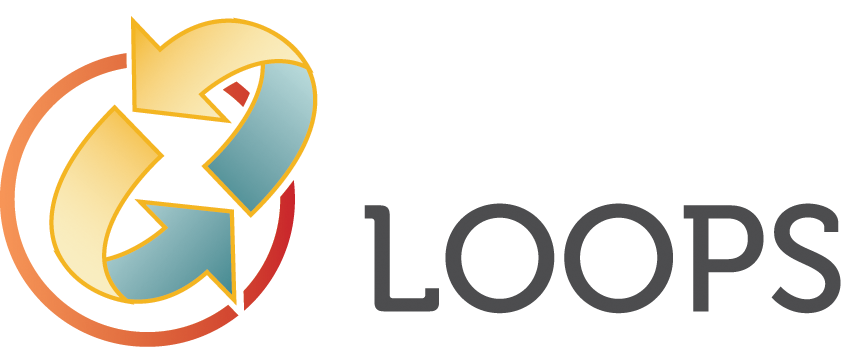
Logging Opportunities in Online Programs for Science
Educational Technology
At Concord Consortium, I was PI of the a five-year NSF-sponsored project called Logging Opportunities In Online Programs For Science (LOOPS). The provided innovative computer-based resources that supported inquiry in the middle school science classroom. The project made innovative use of technology to create timely, valid, and actionable reports to teachers by analyzing assessments and logs of student actions generated in the course of using online curriculum materials that included computer-based models and probes. The reports allowed teachers to make data-based decisions about alternative teaching strategies and were especially important in identifying under-performing students who might otherwise be overlooked. The project, funded by NSF award DRL-0733299, was a collaboration between physical scientists, computer scientists, and learning scientists at Concord Consortium, University of California Berkeley (http://wise.berkeley.edu/), and University of Toronto (http://encorelab.org/). Project members worked closely with teacher-developers to create materials for eighth grade topics of Force and Motion, and Chemical Reactions. The materials were field-tested in California and Massachusetts. For more details see the LOOPS project website.
Publications
Koile, K. and Kimball, N. (2010) "LOOPS Promote Inquiry." @Concord Newsletter, Vol. 14, No. 2, pp. 10-11.
Damelin, D., and Koile, K. (2011) "Technology-Enabled Formative Assessment in the Classroom." In New Frontiers in Formative Assessment. Noyce, P.E. and Hickey, D.T. (editors). Cambridge: Harvard Education Press. pp 175-190. Authors listed in alphabetical order.
Koile, K., Kimball, N., and Pryputniewicz, S. (2012) "LOOPS Offers a Lens On Learning." @Concord Newsletter, Vol. 16, No. 1, pp. 4-6.
Koile, K., Kimball, N., and Pryputniewicz, S. (2013) "Evaluating the Benefits of Technology-Enabled Formative Feedback in the Science Classroom." Presented at the 86th NARST Annual International Conference, April 6-9, 2013.
Documentation
LOOPS Software Manual, Concord Consortium
LOOPS Teacher Manual, Concord Consortium

Sensing Science
Educational Technology
I was co-PI on a Concord Consortium project funded to explore K-2 students' understanding of heat and temperature in two Massachusetts school districts using sensors that display temperatures as colors. The project investigated the following research questions:
- How can visualizations, data collection linked to everyday experiences, and student reflection integrated into creative exploration address student preconceptions and promote K-2 student understanding of temperature and heat?
- How can the use of replay of video and reflection aid in addressing K-2 student preconceptions and improve student understanding of heat and temperature?
- Can the use of visualizations and data collection via digital sensing technology advance K-2 students past the goals of the K-2 science frameworks?
For details see the Sensing Science project website.
Publications
Staudt, C. and Forman, G. (2014) "Sensing Science." @Concord Newsletter, Vol. 18, No. 1, pp. 10-11.

Classroom Learning Partner
Educational Technology
The goal of the Classroom Learning Partner (CLP) project is to improve student learning in large classrooms by increasing instructor-student interaction and studentlearning. In particular, we'd like to turn lectures into more of a two-way conversation between instructor and student than has been possible to date. The two-year project, which began in June, 2005, employs Tablet PC technology to support hands-on activities in the form of in-class exercise: The CLP group is extending an existing Tablet-PC-based presentation system, Classroom Presenter, to support the submission and aggregation of student solutions to in-class exercises (Anderson, et al. 2004).
Using the current Classroom Presenter system, an instructor lectures using a wireless presentation system, annotating slides with digital ink. The slides and ink are displayed simultaneously on a large screen and on students' Tablet PCs. An instructor displays a slide containing an exercise for the students to work. The students work the problem, using digital ink on their tablets, then anonymously submit their answers to the instructor via a wireless network. The answers are collected into a new slide deck on the instructors machine, and the instructor can select individual answers for class discussion. Using Classroom Presenter in this way works well in classes of size eight or smaller (Anderson 2005), as instructors are easily overwhelmed by more than eight solutions. (Student advisees: See CLP website.)
Anderson, R, Anderson, R, Simon, B., Wolfman, S., VanDeGrift, T. and Yasuhara, K.: 2004, Experiences with a Tablet PC Based Lecture Presentation System in Computer Science Courses, in SIGCSE 2004.
Anderson, R: 2005, personal communication with K. Koile.
Koile, K., Chevalier, K., Rbeiz, M., Rogal, A., Singer, D., Sorensen, J., Smith, A., Tay, K.S. and Wu., K.: 2007, Supporting Feedback and Assessment of Digital Ink Answers to In-Class Exercises. In Nineteenth Conference on Innovative Applications of AI, July 22-29.
Publications and Software
Available at: CLP website
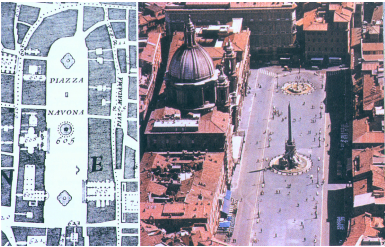
Streetscape: Qualities of Urban Context
Computer-Aided Architectural Design
This study investigates a computational method for representing design knowledge of urban context and using that knowledge to evaluate qualitative characteristics of urban streetscapes. The study focuses on streetscape as an urban element, in particular on the relationship between physical characteristics and experiential qualities of the pedestrian environment.
The design exercise is to understand and manipulate the physical characteristics of the street space so as to realize specified experiential qualities, e.g., approachable. The project goal is to build a prototype system that evaluates experiential qualities of a given urban plan and recommends modifications for better achieving specified qualities. The system will be used to investigate an approachable fence system for Yonsei University, Seoul, Korea, and a revitalized neighborhood for Harvard Square, Cambridge, MA. (Student advisee: Jie-Eun Hwang, Harvard Graduate School of Design)
Publications
- Hwang, J-E. and Koile, K. (2005) "Heuristic Nolli Map: A Preliminary Study in Representing the Public Domain in Urban Space. " In Proceedings of Computers in Urban Planning and Urban Management (CUPUM05), July, 2005.

TAC: The Architect's Collaborator
Computer-Aided Architectural Design
The Architect's Collaborator (TAC) was built to explore two questions: How are abstract terms such as "private" and "open" translated into physical form? How might one build a tool to assist designers with this process? TAC is a design assistant that supports iterative design refinement, and that represents and reasons about how experiential qualities are manifested in physical form. It explores the space of possible designs in search of solutions satisfying specified goals by employing a strategy we've called dependency-directed redesign: it evaluates a design with respect to a set of goals, then uses an explanation of the evaluation to guide proposal and refinement of repair suggestions; it then carries out the repair suggestions to create new designs.
Publications
- Koile, K. (2006) "Formalizing Abstract Characteristics of Style." In AIEDAM Special Issue on Understanding, Representing, and Reasoning about Style, August 2006, 20(3),267-285.
- Koile, K. (2006) "Dependency-Directed Redesign." In preparation.
- Koile, K. (2004) "An Intelligent Assistant for Conceptual Design: Informed Search Using a Mapping of Abstract Qualities to Physical Form." In Proceedings of First International Conference on Design Computing and Cognition (DCC'04), July 19-21, 2004, 3-22.
- Koile, K. (2001) "The Architect's Collaborator: Toward Intelligent Tools for Conceptual Design." Ph.D. dissertation MIT EECS Department, MIT AI Lab TR AITR-2001-001 .
- Koile, K. (1997) "Design Conversations With Your Computer: Evaluating Experiential Qualities of Physical Form." In Proceedings of Seventh International Computer-Aided Architectural Design Futures (CAADF 97), July 1997, R. Junge, ed., 203-218.
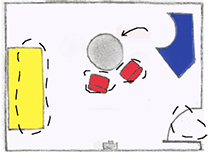
835: Intelligent Workspace
To build workspaces the effectively support people in everyday work situations, one needs to focus on both the technology and the physical environment in which the work takes place. In building our intelligent workspace, the aire group (agent-based intelligent reactive environments) focused on three areas of research. First, we are explored the use of mobile furniture to create a dynamically reconfigurable workspace: as the physical arrangement of the space changes, the technology supporting the space should accommodate accordingly. Secondly, we focused on tools to enable this sort of dynamic configuration: we are developed novel computer vision and other sensing technologies, in collaboration with the Vision Interface Group, for inferring activities in a space. With knowledge of the activities in which a person is engaged, an intelligent workspace can offer relevant assistance. Our third area of research focused on the study of how people use an intelligent workspace such as the one we are building. (Student advisee: Matthew Morrissette)
Publications
- Koile, K., Tollmar, K., Demirdjian, D., Shrobe, H., Darrell, T. (2003) "Activity Zones for Context-Aware Computing." In Proceedings of Ubicomp 2003, October, 2003, 90-106.
- Bentley, F., Tollmar, K., Demirdjian, D., Koile, K., Darrell, T. (2003) "Perceptive Presence." IEEE Computer Graphics and Applications, Special Issue on Perceptual Multi-Modal Interfaces, 23(5): 26-36, September-October.
- Demirdjian, D., Tollmar, K., Koile, K., Darrell, T. (2002) "Activity Maps for Context-Aware Computing." In Proceedings of IEEE Workshop on Applications of Computer Vison (WACV 2002), December 2002.
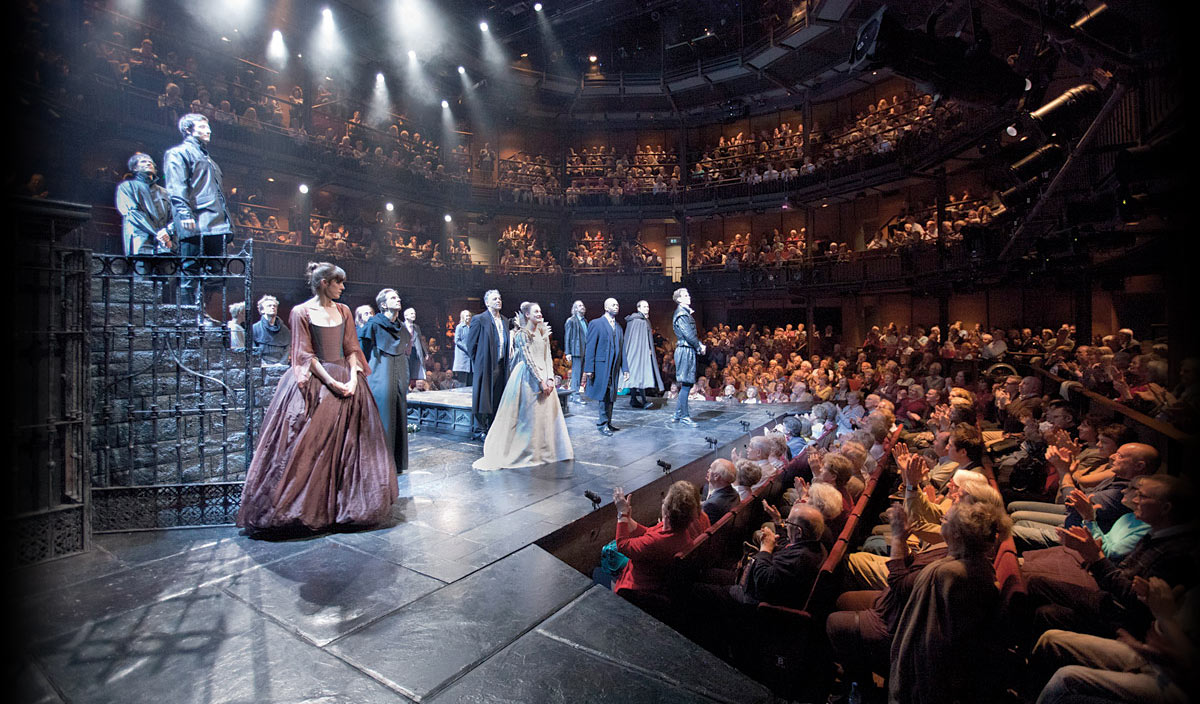
MIT + RSC: Technology and Theatre
MIT and the Royal Shakespeare Company worked together to explore the uses of technology in rehearsing, performing, teaching, studying, and experiencing Shakespeare's work and other classical theatre. The collaboration focused on four areas: rehearsal and performance, educational media, live experience through games, new works. Our group focused on rehearsal and performance and explored the use of "intelligent" technology in rehearsal and performance, leveraging our Intelligent Room ideas to explore designs for an intelligent assistant that would cue actors based on their stage location and prototyping a lighting design assistant that proposed a lighting design based on a set of specified goals. Members of the MIT Comparative Media Studies and Theatre Arts Departments focused oneducational media, creating an interactive documentary to explore new RSC productions from concept through early development, resident production, and tour; games, developing video games in which players are introduced to Shakespearean worlds and narratives by being immersed in a simulated world where they create and improvise with characters in Shakespearean plays; and new works, developing a production that explores the creative process and examines the differences between creating new works in the 17th century and now. (Student advisee: Andrew Perelson)
Publications
- Business week article, May 26, 2003: "Lights, Hologram, Action."
- Perelson, A. (2005, May). "iPlot: An Intelligent Lighting Design Assistant." Master of Engineering Thesis, EECS Department, MIT, Cambridge.
Industrial Work

Arris Pharmaceuticals
Senior Computational Scientist
Computer-Aided Drug Design Group
Leader of a 10-person project that developed andintegrated data analysis tools with data-generating laboratory equipment for synthesis and assay of compounds. Liaison between computer scientists and chemists. Designed overall system architecture; developed domain models for the drug design process, as well as representations for chemical and biological knowledge; developed a user language based on the vocabulary of the drug designer. Member of project team that developed machine learning tools for predicting biological activities from molecular surface characteristics. Responsible for representation of molecular and biological knowledge.
Publications
- Jain, A.N., Koile, K., Chapman, D. (1994) "Compass: Predicting Biological Activities from Molecular Surface Performance Comparisons on a Steriod Benchmark." Journal of Medicinal Chemistry, 37(15): 2315-2327, July 22, 1994.
- Klein, T.E. and Koile, K. (1994) "Molecular Graphics and Drug Design: Introduction." Session introduction in Proceedings of 27th Hawaii International Conference on System Sciences HICSS (5) 1994: 171-172.
- Buettner, J., Koile, K., Shapiro, R., and Webster, T. (1992) "Computer-Directed Mass Production of Peptides." Paper presented at European Peptide Symposium, September, 1992.
- Koile, K. and Shapiro, R. "Building a Collaborative Drug Design System." In Proceedings of 25th Hawaii International Conference on System Sciences (HICSS), January, 1992. Nominated for best conference paper.
- Koile, K., Shapiro, R., Abarbanel, R., Webster, T., Lathrop, R., and Critchlow, R. "Applying AI Techniques to Drug Design: A Preliminary Report." In Proceedings of 1991 AAAI Workshop on AI Approaches to Classification and Pattern Recognition in Molecular Biology, July, 1991.

Unisys
Research Scientist
Knowledge-Based Systems Group
Designed and implemented a system for reasoning qualitatively about gene regulation. Built a knowledge base of molecular biology, along with associated knowledge representation tools.
Publications
- Pastor, J., Koile, K, and Overton, G.C. (1991) "Using Analogy to Predict Functional Regions in Genes." In Proceedings of 24th Hawaii International Conference on System Sciences, January, 1991. Nominated for best conference paper.
- Koile, K. and Overton, G.C. (2004) "A Qualitative Model for Gene Expression." In Proceedings of 1989 Summer Computer Simulation Conference, July, 1989.
- Overton, G.C., Koile, K. and Pastor, J. (1989) "Genesys: A Knowledge Management System for Molecular Biology." In Bell, G. and Marr, T. (editors) The Interface Between Computational Science and Nucleic Acid Sequencing, Addison-Wesley, Reading, MA.
- Pastor, J., Koile, K., and Overton, G.C. (1989) "A Transparent KB-DB Interface." LBS Technical Memo 96, Unisys Paoli Research Center, March, 1989.
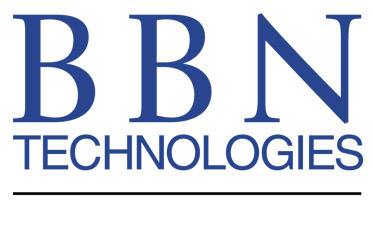
BBN
Research Scientist
Intelligent Systems Group, Life Sciences Group
Designed and implemented knowledge base and user interface for an intelligent system for communication network performance analysis. Designed and implemented a system for protein analysis and design that enabled protein chemists to analyze and compare secondary and tertiary structure of proteins. Designed and implemented a graphical interface for a system that aided chemical engineers in pharmaceutical plant design, and an interface to a natural language system (IRUS).
Publications
- McLaughlin, D., Koile, K. and Walker, E. "IRUS-II User Manual," BBN Report No. 7143, September, 1989.
- Karp. P.D., Koile,K., and Overton, G.C. (1987) "Report of the Metabolic Map Group." In> >Morowitz, H.J. and Smith, T.F. (editors)in Report of the Matrix of Biological Knowledge Workshop, Santa Fe Institute, Santa Fe, NM, October, 1987.
- Koile, K. (1986) "CAPE: Computer-Aided Protein Engineering." Abstract and demonstration, American Chemical Society conference, New York, April, 1986. Also presented at Macromolecules, Genes, and Computers Conference, Waterville Valley, NH, August, 1986.
- Barry, C.D. and Koile, K. (1985) "Towards a Protein Browsery," Abstract, Scientific Computing and Automation Conference and Exposition, Atlantic City, New Jersey, May, 1985.
- Koile, K. and Barry, C.D. "The Unicorn Modeling System," BBN Report No. 5924, April, 1985.
